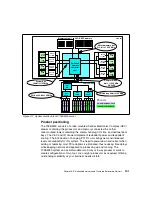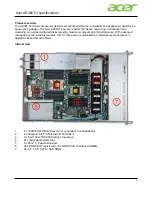
Chapter 3. SP-attached servers and Clustered Enterprise Servers
107
eliminated, thus reducing time delays while keeping network and application
processing up and running. The 7026-6H1 can accommodate one processor
module in its smaller configuration and grow to two, four, or six processors as
required, offering scalability as your business needs dictate.
The 7026-6H1 server is targeted at the key commercial processing segments of
e-business, ERP, SCM, and Business Intelligence. In each segment, the
7026-6H1 can meet critical requirements. For example:
In ERP, the 7026-6H1 is an application server with its powerful processors,
memory capacity, and optional data storage capability.
In e-business, the 7026-6H1 can serve as a business-to-business Web
server, going to other systems for business data or hosting the data storage
itself.
The 7026-6H1’s rack-mounted drawer configuration offers flexibility regarding
the number of CEC and I/O drawers that can be mounted in the rack, providing
more compute and I/O power per square foot of valuable floor space. The
7026-6H1 CEC and I/O drawers each require 5U (EIA Units) of rack space.
Thus, a 7026-6H1 configuration requires only 10U of rack space. This
configuration, which consists of one CEC drawer and one I/O drawer, provides
14 available hot-plug PCI slots with up to six processors and 32 GB of memory.
External disk storage is required for the 7026-6H1 as data storage internal to the
drawers is not provided; however, optional boot bays are available in the primary
/O drawer. (The internal boot disk option requires the space of two PCI slots,
leaving 12 available.) Memory in the CEC drawer can expand up to 32 GB,
providing operating performance for demanding applications.
The 7025-6H1’s reliability implementation, based on the CPU de-allocation
function, enables the system to take a failing processor off line without re-booting
the system. The service processor can record this action and notify the systems
administrator, or service personnel, of the condition. Computing operation
continues with the processor deactivated, allowing repair to be scheduled at a
time convenient to your processing schedule.
Hot-plug functionality of the PCI I/O subsystem brings new levels of up-time to
your system for the replacement or addition of I/O adapters. The design of this
function shows a concern for the usability, convenience, and safety for the
customer who performs this task. Selective disablement of an adapter can be
made, as necessary, while system operations, not dependent on this adapter,
continue to run without being affected. AIX assists the user by guiding him
through the process, helping to ensure success.
Summary of Contents for RS/6000 SP
Page 2: ......
Page 6: ...iv RS 6000 SP and Clustered IBM pSeries Systems Handbook...
Page 16: ...xiv RS 6000 SP and Clustered IBM pSeries Systems Handbook...
Page 48: ...24 RS 6000 SP and Clustered IBM pSeries Systems Handbook...
Page 100: ...76 RS 6000 SP and Clustered IBM pSeries Systems Handbook...
Page 182: ...158 RS 6000 SP and Clustered IBM pSeries Systems Handbook...
Page 218: ...194 RS 6000 SP and Clustered IBM pSeries Systems Handbook...
Page 284: ...260 RS 6000 SP and Clustered IBM pSeries Systems Handbook...
Page 388: ...364 RS 6000 SP and Clustered IBM pSeries Systems Handbook...
Page 436: ...412 RS 6000 SP and Clustered IBM pSeries Systems Handbook...
Page 477: ...0 1 spine 0 1 0 169 53 89 pages RS 6000 SP and Clustered IBM pSeries Systems Handbook...
Page 478: ......
Page 479: ......
















































